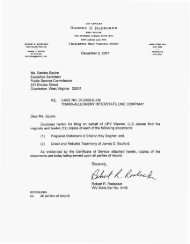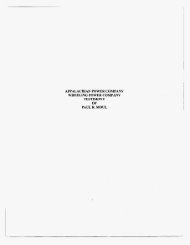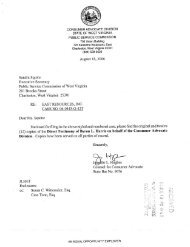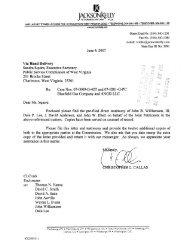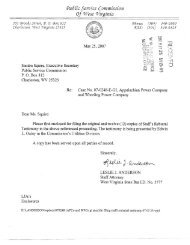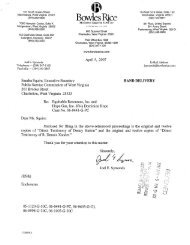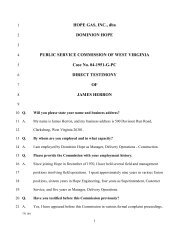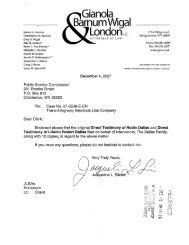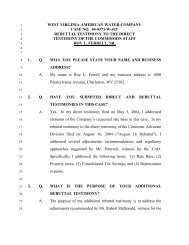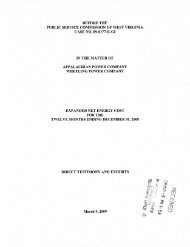Direct Testimony of Thomas M. Hildebrand - Consumer Advocate ...
Direct Testimony of Thomas M. Hildebrand - Consumer Advocate ...
Direct Testimony of Thomas M. Hildebrand - Consumer Advocate ...
Create successful ePaper yourself
Turn your PDF publications into a flip-book with our unique Google optimized e-Paper software.
Virginia Business Magazine: Virginia iaeas, I ne LnesapeaKe tray<br />
raye 4 UI a<br />
the reduction amounts are virtually guaranteed if the technology is properly<br />
implemented. Even so, I would argue that greater per-dollar reduction could<br />
have been achieved by shifting this investment by the state and locality to nonpoint<br />
source controls,<br />
The Commission's five other strategies are ail plans that are viable and currently<br />
in practice on small scales, or are simply under-funded. I am not arguing that<br />
the capacity increase for the regional sewer authority is unwarranted, but if this<br />
spending is aimed primarily at cleaning up the bay, there are other options that<br />
could be more cost effective and achieve greater reductions. In total all six<br />
investments are only projected to meet three quarters <strong>of</strong> the reductions needed.<br />
Litigation<br />
While the state has largely ignored the significant water pollution associated with<br />
agricultural systems, environmental groups have started questioning the legality<br />
<strong>of</strong> their continued high rates <strong>of</strong> pollution. Three environmental groups have<br />
joined forces and threatened a federal suit against two corporations for<br />
overwhelming the SIL wastewater facility in Timberville, Virginia. The waste in<br />
question is primarily poultry and meat processing waste, and its overproduction<br />
is allegedly causing the facility to pollute substantially beyond their permitted<br />
discharge. This case is claiming violations under the CWA, challenging the<br />
corporations' argument that once their waste reaches the SIL treatment facility<br />
they are no longer liable for its release as pollution. While the wastewater facility<br />
is considered a traditional point source and has discharge permits under the<br />
CWA, this allegation is unique in that it is attempting to shift liability from the<br />
permitted facility onto the producers <strong>of</strong> the waste.<br />
This pending case is similar to the federal Concerned Area Residents for the<br />
Environment v. Southview Farm case. In this case the courts held that some<br />
forms <strong>of</strong> large industrial agriculture, which are <strong>of</strong>ten considered the biggest nonpoint<br />
source polluters, can be classified as point sources due to their<br />
concentration <strong>of</strong> nutrient pollution into collection ponds and ditches. This<br />
designation called for Southview Farms, a dairy and crop farm, to be subject to<br />
the same best management practice standards and permitting process as<br />
contained animal feed operations (feedlots), which are regulated as point<br />
sources under the Clean Water Act. Initially the Southview case followed the<br />
same 60 day notice <strong>of</strong> CWA violations as have been given in the pending Virginia<br />
case. If this new case follows the course <strong>of</strong> Southview and the violations are not<br />
addressed, the next step will be for a Judge to find that the processing<br />
companies are alleging continuing violations <strong>of</strong> the CWA. This finding will be<br />
sufficient grounds for the environmental groups to bring a citizens suit, as<br />
decided in Gwaltney <strong>of</strong> Smithfield v. Chesapeake Bay Foundation.<br />
This litigation can be seen as a barometer for public opinion. Citizens are calling<br />
for non-point source polluters to take responsibility for the damage they are<br />
causing to the Bay. Such regulation fits into the action plan the Chesapeake Bay<br />
Foundation has been calling for, and there is some promise for help on the<br />
federal level. The farm bill, due for renewal in September, could contain<br />
provisions quadrupling federal aid to the Chesapeake Bay watershed, totaling<br />
$262.5 million, which would then be matched by the states. One proposal calls<br />
for this funding to be managed by a regional authority, and under this direction<br />
real progress could be made in regulating non-point source pollution in the Bay's<br />
watershed. Unfortunately our legislatures national, state and local have done<br />
very little to help the matter in the past. The Bays' problems have been clearly<br />
evident for decades, but the legislators do not seem at all interested funding a<br />
real solution, rather they have been putting it <strong>of</strong>f by long speeches, studies and<br />
generally finessing it until after the next election.<br />
Saving the Bay<br />
In the long term, several changes must be made if we are to elevate the<br />
Chesapeake from its current classification <strong>of</strong> "dangerously out <strong>of</strong> balance" with<br />
its score <strong>of</strong> 29 by the Chesapeake Bay Foundation to "saved," a score <strong>of</strong> at least<br />
70. Both point and non-point sources must be rigorously managed, and this<br />
management must extend even beyond the agricultural controls that many are<br />
considering. Land use shifts from agriculture to development have incurred high<br />
water pollution in sprawling regions <strong>of</strong> the Bay's watershed. Removing forests<br />
that naturally clean run<strong>of</strong>f and remove nutrients and replacing them with<br />
landscapes that are at susceptible to high amounts <strong>of</strong> erosion is a trend that<br />
must stop. Future developments must be mandated to manage run<strong>of</strong>f and



